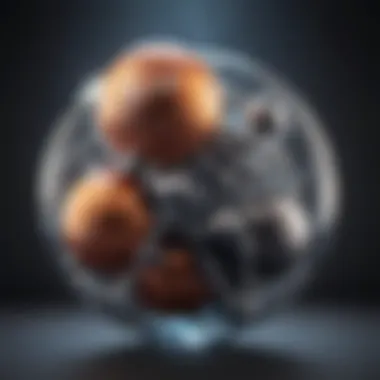Exploring Nitrous Oxide's Role in Depression Treatment


Intro
Depression remains one of the most pressing mental health issues today, with many individuals suffering from persistent symptoms that impact their quality of life. Traditional treatments, such as selective serotonin reuptake inhibitors (SSRIs) and psychotherapy, have their established roles, but they do not work for everyone. Recently, researchers are exploring alternative therapeutic options, including nitrous oxide, traditionally known as laughing gas. This article covers the exploration of nitrous oxide as a potential treatment for depression, its mechanism of action, and research findings in the field.
Key Findings
Major Results
Recent studies have shown that nitrous oxide can produce rapid antidepressant effects. Unlike conventional antidepressants, which may take weeks to show efficacy, nitrous oxide has demonstrated quicker responses in patients. A notable study published in Psychiatry Research revealed that patients experienced significant improvements in depressive symptoms after a single administration of nitrous oxide. The reductions in symptoms like hopelessness and anxiety were notable within just hours following treatment.
Discussion of Findings
The findings suggest that nitrous oxide might enhance the function of neurotransmitters, including glutamate. This is significant, as glutamate is associated with mood regulation. Moreover, several clinical trials indicate that nitrous oxide can be well tolerated in patients, making it an interesting alternative or adjunct to traditional therapy. However, further empirical data is necessary to validate these effects comprehensively.
Methodology
Research Design
To understand nitrous oxide's role in depression treatment, researchers have employed various methodologies. They often utilize double-blind, placebo-controlled trials to ensure that findings are robust and objective. These designs help minimize biases and provide high-quality evidence regarding the drug's effectiveness.
Data Collection Methods
Effective data collection is crucial for assessing nitrous oxide's impact on depression. Commonly, researchers employ self-reported questionnaires alongside clinician assessments to gauge changes in mood and overall mental health. Instruments like the Montgomery-Åsberg Depression Rating Scale (MADRS) are widely used to quantify depressive symptoms. They also utilize neuroimaging techniques to observe the drug's effects on brain activity, adding another layer to their findings.
"Understanding the mechanism of nitrous oxide is as important as evaluating its outcomes, as this knowledge will inform future treatment approaches and safety protocols."
Prelims to Nitrous Oxide
Nitrous oxide, commonly referred to as laughing gas, has gained attention in recent years as a potential treatment for depression. The significance of this topic lies in the urgent need for effective alternatives to traditional antidepressants, which may not work for everyone and often come with a range of side effects. Understanding nitrous oxide's role in mental health can provide insights into innovative approaches to treating depression. This introduction will highlight the historical context and current applications of nitrous oxide within the field of medicine.
Historical Context
The use of nitrous oxide dates back to the 19th century. Initially, it was utilized in dentistry and surgery for its anesthetic properties. As medical practices evolved, the potential for nitrous oxide to alleviate pain and anxiety became apparent. In the 1930s, researchers began to explore its effects on mood disorders, but significant clinical research on its use for depression did not emerge until the last decade. This historical backdrop indicates a transition from its primary role in anesthesia to a possible therapeutic agent in psychiatry, showcasing a paradigm shift in how nitrous oxide is perceived in mental health treatment.
Current Applications in Medicine
Currently, nitrous oxide is most widely applied as an anesthetic during various medical procedures. It serves to promote relaxation and ease pain for patients. However, its role has expanded into areas such as emergency medicine and outpatient settings due to its rapid onset and relative safety. Recent interest also focuses on its promise as a treatment for mental health conditions. Researchers investigate the gas's effects not only as an analgesic but also as a potential modifier of mood and emotional states.
Nitrous oxide operates on neurotransmitter systems, influencing chemicals such as serotonin and dopamine, which are critical in mood regulation. By presenting a unique option, nitrous oxide might revolutionize depression treatment protocols, appealing especially to patients for whom other treatments have failed.
Recent studies suggest that nitrous oxide's rapid effects may offer immediate relief in acute depressive episodes, setting it apart from traditional medications that often require weeks to take effect.
Understanding Depression
Understanding depression is crucial to exploring the role of nitrous oxide in treatment methodologies. Depression is a complex mental health disorder that can significantly affect an individual's quality of life. It is not merely a feeling of sadness but a multifaceted condition that can manifest in various forms, including major depressive disorder, persistent depressive disorder, and seasonal affective disorder. Recognizing these distinctions is essential, as the effectiveness of the treatment may vary based on the specific type of depression being addressed.
Prevalence and Impact
Depression is one of the leading mental health issues globally. Approximately 300 million people are affected by depression, according to the World Health Organization. The disorder's prevalence highlights the urgency of developing effective treatments. Depression can have a profound impact on various aspects of life including work, relationships, and physical health. Furthermore, the economic burden associated with depression is significant, with costs arising from lost productivity, healthcare expenses, and disability claims.
Understanding these implications emphasizes the need for innovative treatment options such as nitrous oxide therapy, which could provide relief to those for whom traditional antidepressant medications have been ineffective or insufficient.


Traditional Treatment Methods
Traditional treatment methods for depression typically include psychotherapy and pharmacological intervention. Antidepressants such as selective serotonin reuptake inhibitors (SSRIs) remain the most commonly prescribed medications. While these medications can be effective for many, they are not without limitations. For example, SSRIs can take several weeks to exhibit effects, and some patients experience side effects that discourage continued use. Cognitive-behavioral therapy is also a popular approach, helping individuals manage their thought processes and behaviors.
However, as the landscape of mental health treatment evolves, there is recognition that some patients do not respond adequately to these conventional strategies. This drives the need for exploring alternatives like nitrous oxide. By examining its potential alongside traditional methods, healthcare professionals can broaden their toolkit and improve patient outcomes.
"The urgency of addressing depression cannot be overstated; mental health treatment innovations are imperative to give hope and healing to those affected."
Mechanism of Action of Nitrous Oxide
Understanding the mechanism of action of nitrous oxide is crucial for grasping its potential role in depression treatment. The pharmacological effects of nitrous oxide are multifaceted, influencing several biological systems in the body. This section details the specific aspects of how nitrous oxide operates and the implications of its usage in psychiatric care.
Pharmacodynamics
The pharmacodynamics of nitrous oxide involve its interaction with the central nervous system. This gas, often known for its anesthetic properties, exhibits unique characteristics when administered in lower doses. When inhaled, nitrous oxide quickly crosses the blood-brain barrier and binds to various receptors in the brain. Notably, it affects NMDA receptors, which play a pivotal role in mood regulation and neurotransmission.
One of the significant features of nitrous oxide is its ability to induce a state of partial dissociation. As a result, patients may experience altered perceptions and enhanced emotional responses. These effects are often temporary but can influence mood positively during and after administration.
Importantly, nitrous oxide does not appear to have the same addictive potential as substances like opioids or benzodiazepines, making it a candidate for further exploration in therapeutic settings. However, like any treatment, its pharmacodynamics necessitate comprehensive study to assess long-term implications and dosages.
Neurotransmitter Interaction
Nitrous oxide interacts primarily with neurotransmitters in the brain. It notably influences the release of several key neurotransmitters, including dopamine, serotonin, and norepinephrine. These neurotransmitters are critical in regulating mood and emotional responses.
Research indicates that nitrous oxide can enhance the release of dopamine, which plays a role in the feeling of pleasure and reward. This stimulation may lead to mood improvement, making it a point of interest for treating depression. Additionally, its effects on serotonin and norepinephrine can help remedy symptoms commonly associated with depressive disorders.
"Understanding how nitrous oxide impacts neurotransmitter levels is key to identifying its therapeutic potential for mood disorders."
In summary, the mechanism of action of nitrous oxide involves complex interactions between various receptors and neurotransmitters. The pharmacodynamics of nitrous oxide allow its compounds to influence mood-related processes significantly while offering a unique alternative to traditional antidepressant therapies. Future research will be vital in validating these initial findings and unraveling further potential applications for this gas in treating depression.
Clinical Evidence Supporting Nitrous Oxide for Depression
The role of nitrous oxide in treating depression is gaining attention in clinical settings. Understanding the clinical evidence surrounding its use is essential for both medical practitioners and researchers. This section addresses the most current studies and findings regarding nitrous oxide's application in depression treatment, evaluating its effectiveness and potential benefits compared to traditional therapies.
Recent Studies and Findings
Recent studies have highlighted the promising potential of nitrous oxide in alleviating depressive symptoms. Research published in reputable journals indicates that nitrous oxide can produce rapid antidepressant effects. For example, a randomized controlled trial examined the impact of nitrous oxide on patients with treatment-resistant depression. Participants reported significant reductions in depressive symptoms after just one session of nitrous oxide administration.
This rapid onset of effect is notable, as traditional antidepressants often require weeks to achieve visible results. Furthermore, studies have compared nitrous oxide to commonly used treatment methods, including selective serotonin reuptake inhibitors (SSRIs) and ketamine. The findings suggest that nitrous oxide may serve as an effective alternative or supplementary treatment for those who do not respond adequately to conventional approaches.
Comparative Effectiveness
Versus SSRIs
Comparing nitrous oxide with SSRIs reveals several important aspects. SSRIs, like fluoxetine and sertraline, are among the first-line treatments for depression. However, they may come with various side effects and delayed onset of action, which can discourage patient adherence.
In contrast, nitrous oxide often requires fewer sessions and is associated with a lower side effect profile. The unique characteristic of nitrous oxide is its ability to induce rapid changes in mood. This attribute can lead to a quicker sense of relief for patients who are struggling. Although SSRIs remain a popular choice for long-term management, nitrous oxide offers a beneficial complement for those requiring immediate support.
Versus Ketamine
Ketamine has emerged as a noteworthy competitor in the domain of rapid antidepressant therapies. Its use has garnered attention due to its effectiveness in cases of severe, treatment-resistant depression. However, the administration of ketamine generally requires careful monitoring and is often delivered in a clinical setting.


The benefits of nitrous oxide arise from its ease of administration and its potential for greater accessibility. While ketamine may offer profound effects, the logistics surrounding its use can be a barrier. Nitrous oxide presents a less cumbersome option that can achieve similarly effective outcomes while ensuring patient comfort.
Versus Placebo
In the context of studies comparing nitrous oxide to placebo, findings are compelling. Research has consistently shown that nitrous oxide outperforms placebo in alleviating depressive symptoms. This correlation reinforces the therapeutic value of nitrous oxide, confirming its validity as a treatment option.
One important aspect is the significance of establishing efficacy beyond placebo effects. The clear distinction between nitrous oxide and placebo demonstrates the substance's genuine impact on mood regulation. Patients receiving nitrous oxide frequently report higher satisfaction levels and noticeable improvement when contrasted with those on placebo treatment.
"The compelling evidence surrounding nitrous oxide not only supports its role as an adjunct treatment for depression but also highlights its potential as a primary therapeutic option."
In summary, the clinical evidence establishing nitrous oxide as a viable treatment for depression presents a crucial development in psychiatric care. Its rapid action, practical administration, and favorable patient outcomes position it as an essential area for ongoing research and clinical implementation.
Safety and Side Effects
The topic of safety and side effects is paramount when discussing any potential treatment for depression, including nitrous oxide. As the field of mental health continues to explore alternative therapies, understanding both the risks and benefits associated with nitrous oxide use is essential for both practitioners and patients. This section examines how nitrous oxide can be safely integrated into treatment protocols and evaluates the potential side effects that may arise from its use.
Short-term Effects
Nitrous oxide is often used for its fast-acting properties, which can be beneficial in acute settings. Patients undergoing treatment may experience immediate effects such as euphoria, relaxation, and an altered state of consciousness. While many welcome these sensations, they come with a spectrum of short-term side effects. Commonly reported effects include:
- Nausea
- Dizziness
- Drowsiness
- Mild disorientation
- Headaches
These effects are usually transient and resolve shortly after the cessation of use. Despite their temporary nature, it is crucial for healthcare providers to monitor patients closely to ensure their well-being. Additionally, the administration should occur in a controlled environment to mitigate any potential adverse reactions.
Long-term Risks
The long-term safety of nitrous oxide in depression therapy is less well understood compared to more traditional treatments. Prolonged exposure to nitrous oxide can lead to several risks, which must be carefully weighed against its potential benefits. Some of the identified long-term risks include:
- Vitamin B12 Deficiency: Nitrous oxide may inactivate vitamin B12, leading to neurological issues, including numbness and balance problems.
- Dependency Risks: There is a potential for misuse and psychological dependency, particularly if used outside medical guidelines.
- Neurological Damage: Chronic exposure, particularly through recreational use, has been linked to more severe neurological conditions.
Long-term effects of any new treatment modality must be prioritized for rigorous research to promote safe and effective clinical practices.
Such risks necessitate a cautious approach. Potential patients should have thorough evaluations before treatment begins. Regular follow-ups are essential to monitor any adverse developments. Clear guidelines and education about the responsible use of nitrous oxide can help mitigate these risks as research in this area advances.
Implications for Treatment Protocols
The exploration of nitrous oxide as a treatment for depression brings forth significant implications for current treatment protocols. Understanding how nitrous oxide might fit within existing frameworks is crucial for providers aiming to optimize care for patients requiring mental health interventions. The integration of novel therapies like nitrous oxide can offer enhanced outcomes, reduce response times, and provide alternative pathways for those who do not respond to conventional therapies.
Integration with Current Therapies
Integrating nitrous oxide into current therapeutic practices requires careful consideration of how it can complement or enhance existing treatments like selective serotonin reuptake inhibitors (SSRIs) or psychotherapy.
- Combination Therapy: Combining nitrous oxide with traditional modalities could yield synergistic effects. For instance, using nitrous oxide to provide rapid relief while simultaneously engaging patients in cognitive behavioral therapy may address immediate distress and foster long-term coping strategies.
- Personalized Treatment Plans: Individualizing treatment plans based on the patient's history, preferences, and specific symptoms is essential. The quick onset of action associated with nitrous oxide may allow for faster adjustments in treatment protocols when patients show minimal improvement with standard approaches, giving access to a more tailored approach in managing treatment resistant depression.
- Safety Monitoring: Close monitoring is vital when integrating nitrous oxide, especially for patients with complex backgrounds. This involves being vigilant about the potential for adverse reactions and ensuring that protocols prioritize patient safety from the start.
Proposal for Clinical Guidelines
As nitrous oxide’s role in depression treatment evolves, developing clinical guidelines becomes necessary to ensure its safe and effective use. In proposing such guidelines, several key factors must be considered:
- Indications for Use: Clear criteria need to define when to consider nitrous oxide as a treatment option. Understanding which patients may benefit the most can help target the therapy effectively.
- Dosage and Administration Protocols: Establishing standardized dosages and best practices for administering nitrous oxide will be important to maximize therapeutic effects while minimizing risks. It may require collaborative research efforts to derive these metrics from clinical trials and ongoing studies.
- Follow-Up Care: Creating a follow-up regimen is essential to monitor patient progress and manage any emerging side effects. The absence of a robust strategy could undermine the positive outcomes associated with nitrous oxide use.
These elements should not only inform clinical practices but also establish a framework that caregivers can rely on for integrating nitrous oxide seamlessly into their treatment offerings.


As evidenced by research, the potential of nitrous oxide as a treatment for depression represents a shift in the paradigm of psychiatric care, suggesting a need for modified treatment protocols to harness its benefits.
Future Directions in Research
The exploration of nitrous oxide in the treatment of depression signifies a pivotal juncture in psychiatric care. As the landscape of mental health treatment evolves, understanding the future directions in research is critical for advancing therapeutic options. This section will focus on potential developments in treatment, alongside the exploration of novel applications, emphasizing the benefits and considerations that accompany these avenues.
Potential Developments in Treatment
Future research on nitrous oxide aims to refine its application in clinical settings. One area of focus is optimizing dosage protocols to enhance efficacy while minimizing side effects. Current findings suggest that low doses may provide antidepressive effects without the pronounced dissociative symptoms often associated with higher concentrations. Identifying the ideal delivery method is another consideration. Conventional administration through inhalation can be supplemented with alternative routes, such as intravenous methods, which may offer faster onset of action.
Another promising direction involves combining nitrous oxide with existing antidepressants. This synergistic approach may lead to improved outcomes for patients who do not respond adequately to standard treatment modalities. Investigating the mechanisms of action further, including how nitrous oxide interacts with neurotransmitter systems, remains essential.
Additionally, it is crucial to understand the long-term effects of nitrous oxide use in depression treatment. As studies progress, continuous evaluation of safety and psychological outcomes will help establish the viability of nitrous oxide as a primary or adjunctive treatment option.
Exploration of Novel Applications
Investigating nitrous oxide's application beyond traditional depression indicates an expansive horizon for mental health treatment. One avenue is the potential role of nitrous oxide in managing treatment-resistant depression (TRD). Given the suboptimal response rates of current therapies for TRD, alternative approaches such as nitrous oxide may provide relief for this difficult-to-treat population.
Furthermore, research could extend to exploring nitrous oxide’s effects on anxiety disorders and PTSD. Early findings suggest that its rapid-acting properties might alleviate symptoms associated with these conditions, offering hope to a broader spectrum of patients.
Emerging technologies also present opportunities to study nitrous oxide in varied delivery systems. For example, intranasal formulations are being examined for their ease of use and rapid absorption, which could revolutionize emergency treatment situations.
Ultimately, the continual exploration of nitrous oxide can significantly alter the future of psychiatric treatments, opening doors to innovative solutions and enhancing the quality of life for those suffering from mental illness.
Ethical Considerations
The exploration of nitrous oxide as a treatment for depression introduces various ethical considerations. These considerations are crucial for ensuring that the application of this gas aligns with established medical and ethical standards. Several factors come into play, affecting how nitrous oxide is utilized in psychiatric care.
Informed Consent is one of the primary ethical components. This requires that patients are given comprehensive information regarding the procedure, benefits, risks, and potential side effects of nitrous oxide treatment. It is vital that patients understand what their involvement entails, including any uncertainties in the efficacy of this treatment compared to traditional methods. Without proper informed consent, patients cannot make educated decisions about their health.
Additionally, there is a pressing need to ensure access and equity in treatment. Not all patients have the same ability to access innovative treatments like nitrous oxide. Socioeconomic status, geographical location, and healthcare coverage can significantly impact who can benefit from this therapy. A fair approach to distribution ensures that marginalized communities also receive equal opportunities for treatment.
"Ethical considerations in treatment options ensure patient safety and promote equitable healthcare access."
By addressing both informed consent and equitable access, healthcare providers can foster a framework that prioritizes ethical treatment protocols. This alignment can pave the way for responsible integration of nitrous oxide into practice, potentially improving the quality of care for those suffering from depression.
Closure
The conclusion serves as a critical reflection on the discussions presented throughout this article regarding nitrous oxide's role in treating depression. It emphasizes a multifaceted understanding of the various aspects that contribute to its therapeutic potential. As mental health needs continue to grow, exploring innovative solutions becomes increasingly important. Nitrous oxide's unique pharmacological properties and its efficacy in clinical settings indicate significant promise in depression management.
One essential element discussed is the comparative effectiveness of nitrous oxide against traditional antidepressants. Each individual responds differently to treatment, making it crucial to consider multiple options. The emerging evidence suggests nitrous oxide may offer rapid action, a characteristic that could be vital for patients experiencing acute depressive episodes.
This article also underscores the importance of safety considerations. Understanding the short and long-term effects is necessary before this treatment can be widely adopted in clinical settings. Health professionals must ensure that they are making informed decisions regarding the use of nitrous oxide, considering risks alongside benefits.
Furthermore, the ethical considerations related to informed consent and equitable access to this treatment are paramount. As nitrous oxide emerges as a possible treatment, it is essential that health systems address barriers to ensure all patients have fair access to innovative therapies.
In sum, extensive research and clinical evaluation of nitrous oxide's applications in depression treatment are warranted. This exploration opens the door for potential breakthroughs that could change lives. Offering a blend of established and novel approaches could greatly enhance mental health care.
Summary of Key Findings
- Pharmacological Properties: Nitrous oxide acts as an NMDA receptor antagonist and influences neurotransmitter systems.
- Clinical Evidence: Recent studies show promising outcomes, demonstrating rapid relief from depressive symptoms compared to traditional antidepressants.
- Safety Profile: Understanding both short-term and long-term effects is essential for responsible practice.
- Ethical Considerations: Access to treatment and informed consent are crucial in utilizing nitrous oxide.
- Future Research Directions: Ongoing studies are necessary to fully grasp the potential and limitations of nitrous oxide in treating depression.
Final Thoughts on Nitrous Oxide and Depression
The exploration of nitrous oxide as a treatment for depression reflects a paradigm shift in psychiatric care, where traditional methods are no longer the sole focus. This article highlights that while nitrous oxide shows significant promise, it must be approached with caution and thorough scientific scrutiny.
As mental health conditions continue to challenge healthcare systems worldwide, the need for diverse treatment options is urgent. Nitrous oxide might address certain limitations associated with existing treatments, offering a new avenue for patients who have not found relief from conventional therapies. The integration of innovative treatments into existing protocols requires collaboration among researchers, clinicians, and policymakers.



